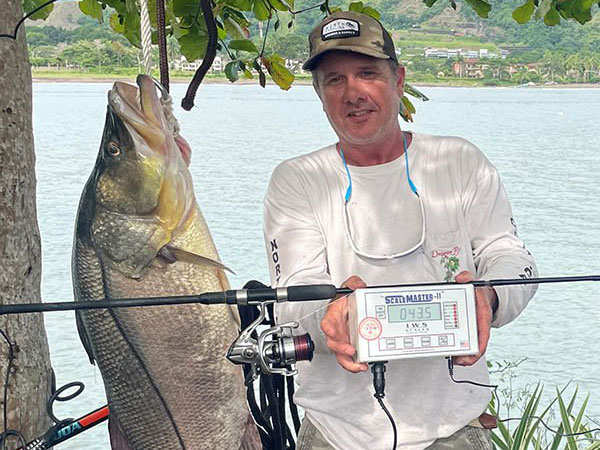Courtesy George Beckwith
In early July Capt. George Beckwith, of North Carolina charter fishing fame, was on a four-day fishing adventure out of Quepos, on the central west coast of Costa Rica, located south of San Jose, the capital city.
First day offshore in the Pacific Beckwith and pals slammed yellowfin tuna to 60 pounds using top-water popping plugs.
On days two and three, Beckwith with good friend and fly-rod billfish angler Jake Jordon did an overnighter out of Quepos. They caught six blue marlin in the 100-to-250-pound class all on regulation fly tackle. Beckwith had four marlin, Jordon two, all released.
With that kind of stellar fishing most anglers would have taken a day off the water to recoup. But not Beckwith.
“I wanted a big snook for a possible 6-pound line class record,” says Beckwith, 52, who runs Down East Guide Service out of Morehead City, N.C., plus trips to Costa Rica. “My long-time Costa Rican buddy Capt. Roy Zapata Calderon was available. So he and I and Jordon went after snook on that fourth day off Quepos.”
Using specialized light-tackle IGFA regulation gear, including a Shimano 4000 Stradic reel spooled with true-tested IGFA 6-pound Black Widow line, and a very long and “forgiving” 9-foot spinning rod, the anglers set out in the rolling swells of the Pacific Ocean to hunt for oversize snook.
First the anglers found and caught live sardines near the beach, then put out the baits for trolling. They caught a couple smaller snook, still looking for a potential record fish, when a heavyweight took Beckwith’s bait.
“That fish made a run and took about half the line off the spool,” says Beckwith. “We ran closer to the fish and the snook tried to jump and got about half out of the water. That’s when we knew it was the fish we were looking for and for sure it was bigger than the existing 6-pound test snook record. At the time Roy thought it might be an all-tackle record because it was so huge.”
Beckwith says they positioned the boat close to the fish again trying to get it in. But the center-console was near the beach and huge Pacific Ocean roller waves the area is famed for was pitching and wallowing the boat.
“The snook was trying to get to the other side of the breakers near the beach where we couldn’t follow it, and surely would lose it,” Beckwith explained. “So I had to really put pressure on the fish to get it out of the area.”.
The long, whippy custom spinning rod he used helped cushion the fight of the heavyweight snook, almost like a fly rod would do in a similar fashion.
Finally, Beckwith got the fish close to his boat, and he grabbed the 10-foot length of 50-pound test shock leader at the end of his 6-pound line. Beckwith then knew the snook was his.
“Holding the 50-pound test leader, I walked the snook to Roy and his mate who held a dip net, and we got the fish in the boat,” described Beckwith. “Then we put it in the boat’s live baitwell, which was barely big enough for it to fit inside,”
The anglers immediately called Quepos alerting them they had caught what surely was an IGFA record snook. They kept the snook alive and got it to Marina Pez Vela in Quepos, where it weighed 43-pounds, 8-ounces. But they were concerned the weigh scale wouldn’t qualify as being a certified one. So they then drove the fish to another set of scales in Los Suenos, where it weighed 43-pounds, 5-ounces on certified scales. The snook didn’t survive the trip to Los Suenos, as it otherwise would have been released by Beckwith.
The Pez Vela scale was certified, however, and the fish’s heavier weight has just been accepted by IGFA as the new men’s 6-pound test line class world record for the species. Beckwith’s snook betters the previous 6-pound line class record Pacific snook by nearly 12 pounds.
The former Pacific snook 6-pound line test men’s record weighed 31-pounds, 10-ounces, taken by Alberto Acuna in May 2005, also in Costa Rica.
“My only regret is we couldn’t release that beautiful snook back into the Pacific,” says Beckwith. “But the drive to the second set of weigh scales was too much for it to survive.
Credit: Source link






























